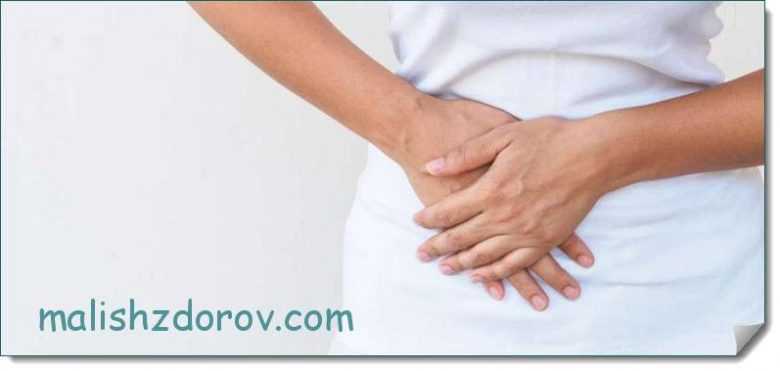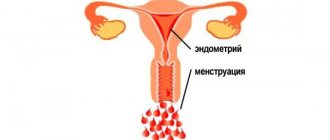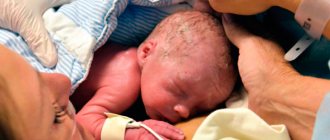Physiological state of a woman
From the first days after conception, the body of the expectant mother undergoes various changes. First of all, this concerns hormonal levels. The first and most important sign of pregnancy is the absence of menstruation.
In this case, the presence of mild or moderate nagging pain in the lower abdomen is considered quite normal. This is due to the restructuring of the body and the preparation of the reproductive organ for bearing a fetus.

What other signs might appear?
In addition to discomfort in the lower abdomen, girls in an interesting position often encounter other associated symptoms. These include:
- Increased breast size, swelling and increased sensitivity of the nipples.
- Apathy, fatigue, irritability, drowsiness.
- Mood swings.
- Digestive disorders, flatulence, nausea.
- Changes in taste preferences, heightened sense of smell.
- A sharp increase or, conversely, decrease in appetite. Against this background, weight gain or loss.
- Often during pregnancy, a problem such as constipation develops.
- Frequent urination.
- Headache and dizziness.
These signs indicate that the girl will soon become a mother. Of course, to confirm an interesting situation, it is not enough to simply listen to such manifestations of the body.

A woman must definitely visit the hospital, take a blood test for hCG and undergo a gynecological examination. In one of our articles you can read more about hCG in different weeks of pregnancy.
The family that never stopped growing
“I liked having children”
Jennifer Shuart from Michigan
Jennifer Shuart is a Michigan mom who gave birth to three children, each of whom was born heavier than the last. Jennifer's first child weighed 4 kg, the second - 4.5 kg, and the third - 5 kg. This means her last baby weighed more than the average newborn, which weighs about 3.7 kg.
However, the significant weight of the third child did not seem to have any impact on the birth process.
“Three pushes and the child came out. No epidurals or other medical interventions. When people saw how big my baby was, they couldn't believe I gave birth naturally without painkillers. He was simply huge. He looked like a monster compared to the other babies in the nursery."
Jennifer Shuart
Of course, it should be understood that baby size is relative. Even a baby weighing 3.7 kg will be large for a woman with a narrow pelvis, whose weight is 45 kg. However, any child who weighs more than 4.5 kg is classified by doctors as large.
“No one wants to give birth to a baby who is not yet ready to be born, but I had a patient who was carrying two 4.5 kg children who also had shoulder dystocia (when the width of the baby’s shoulders is too wide for the birth canal ). She was very concerned about this and we ended up inducing labor at 37 weeks."
Gerald Joseph, a midwife at the Ochsner Clinic in New Orleans
As with most large babies (though not all; Shuart was an exception), the patient suffered from diabetes, one of the most common causes of excess birth weight.
Thanks to insulin, doctors can now more effectively control diabetes during pregnancy. For this reason, the birth of large children is now a rare occurrence.
What pain sensations can there be?
In the early stages of bearing a baby, expectant mothers often encounter discomfort in various parts of the abdomen. As we have already said, these can be normal physiological pain, as well as various pathological conditions. Harmless pain at the beginning of pregnancy is usually mild and goes away on its own within a few minutes. In this case, discomfort may be observed in the lower abdomen or in the lumbar region. It is often explained by sprained uterine ligaments or a condition such as the implantation of the fertilized egg into the wall of the reproductive organ. But there are other pains.
Pulling
Starting from 2-4 weeks of gestation, the concentration of hormones in the female body is already quite high. The peak of the hormonal surge is observed at 5, 6, 7, 8 weeks. Some hormones during this period have a direct effect on the intestines. Progesterone relaxes the smooth muscles of the stomach and intestines, which leads to a decrease in the peristalsis of these organs. As a result, dull, pulling sensations may appear in the lower abdomen. On the right, the pain will be more pronounced, and increased gas formation may also be observed.

To prevent this condition, the expectant mother is advised to follow a proper, balanced diet and drink more fluids. This is especially important before 11-12, 17-18 weeks. Physical activity will also have a positive effect. It is better to give preference to walking, smooth bends and turns. You must first consult your doctor.
Piercing
During pregnancy, a woman may also experience stabbing pain. It can radiate to the lower back, left or right. Such sensations often indicate increased uterine tone, but there are other reasons. Let's look at them in more detail:
- Increased uterine tone. To reduce discomfort, the expectant mother should take a horizontal position and breathe deeply. If we are really talking about tone, the discomfort should disappear after a few minutes.
- Often, aching pain for a short period of time is accompanied by bloating and constipation. This condition is explained by a violation of the digestive process.
- Stitching sensations often occur with cystitis. In this case, the woman will also encounter symptoms such as pain when urinating, frequent urge to go to the toilet. Body temperature can rise to 37°C, less often to 38-39°C.
- Stitching pain in early and late stages is a common symptom encountered with uterine bleeding. If a woman experiences such a symptom and discovers bloody discharge, she should immediately go to the hospital.
For 3-7 months, stabbing pain often occurs with an ectopic pregnancy. If the fertilized egg, for example, is fixed in the fallopian tube, it grows every day, putting pressure on the walls of the organ. There is a risk of rupture of the fallopian tube. If you feel discomfort, you should not let the situation take its course. The girl needs to seek medical help.

If the pain is severe and there is bleeding, this may indicate an incipient miscarriage. Thanks to the methods of modern medicine, this dangerous phenomenon can often be prevented with timely consultation with a doctor.
Read more about ectopic pregnancy. Every woman should know about this dangerous condition.
On right
If at the initial stage of bearing a baby a woman has aching and pulling on the right side, it is important to pay special attention to this. The fact is that in this area there are such vital organs as the liver, gall bladder, and part of the intestines. When these organs are diseased, discomfort often occurs in the upper abdomen. Pathology is indicated by discomfort in the right hypochondrium. Sometimes it happens that discomfort occurs first on the right, persists for several hours, and then is localized in the umbilical region. In this case, we can most likely talk about appendicitis. The pathology may also be accompanied by an increase in body temperature up to 40°C.

Another cause of such pain is an ectopic pregnancy in the right fallopian tube. The expectant mother should immediately go to the hospital if the discomfort does not go away within half an hour at rest. In such a situation, she urgently needs medical help.
Left
Left-sided pain in most cases indicates problems with the intestines, for example, intestinal obstruction. In addition, discomfort on this side often indicates pancreatitis. This disease can occur both in the early stages of pregnancy and at a later stage, for example, at 35-36 weeks.
Pain like before menstruation
Some girls complain that in the early stages of pregnancy they have feelings like when their period comes. It's like they're gone, but there's no bleeding. This often occurs approximately 7-10 days after unprotected intercourse. This period, as a rule, coincides with a process such as the implantation of the fertilized egg into the wall of the uterus. In this case, the girl may notice slight bleeding, which is a completely normal physiological phenomenon.

The duration of discomfort may vary, from several hours to several days. After this, the pain disappears on its own without any complications. If no associated negative symptoms occur, there is no need to worry. At the beginning of pregnancy, immediately after a delay, the expectant mother may experience pulling sensations in the lower abdomen. If every day these unpleasant feelings intensify and become more noticeable, it is quite possible to assume such a dangerous condition as ectopic implantation of the fertilized egg. In addition to painful sensations, this pathology is often accompanied by other symptoms. Bleeding is common among them.
Fun trip
Molly McKay Zucker and her husband, Dave, of St. Charles, Illinois, didn't want to sit in the hospital for hours waiting for their second child to be born. But they also didn’t want to be late to the hospital when the active stage of labor began. So when Molly went into labor, she and her husband called home a midwife who would go with them to the hospital and help them until they arrived. Things didn't have to be rushed, as second labor usually lasts between 3 and 6 hours. However, everything did not happen as planned. Molly gave birth to her daughter 1 hour 25 minutes after labor began, just a mile from the hospital. The girl was born in the back seat of the family minibus.
“My water broke when we had only been on the road for seven minutes and I told my husband and midwife that I couldn’t hold the baby anymore. The midwife drove the car. She parked our minibus and came to me in the back seat. I pushed once and my baby’s head appeared.”
Molly McKay Zucker, Illinois
Despite the unconventional birth, mother and baby were completely healthy; they spent the night in the hospital and returned home the next day.
Why did Emmy's birth go so quickly? Experts cannot give an exact answer to this question.
“If I could understand what makes some births so fast, I could retire with a clear conscience.”
Siddiqui, gynecologist
However, there are some factors that can affect the length of labor: previous births, adequate head size of the baby, intrauterine infections that can stimulate contractions - all of these can speed up the process of having a baby.
How fast can labor be? Any labor that lasts less than two hours from the start of the active phase (when the cervix is 4 cm dilated) is considered very fast. Doctors warn that such a rapid process of childbirth also has a negative side, including an increased risk of rupture of vaginal tissue. However, this is not always the case: Emmy needed only three stitches after the birth of her first child and none after her second. “I guess I just have elastic skin,” says the happy mother of two.
Help for lower abdominal pain at home
Is it possible to help yourself at home without harming the fetus? The first thing a woman needs to do when discomfort occurs is to calm down, take a lying position and breathe deeply. If spotting appears, you must urgently call an ambulance and take No-Shpu or Papaverine.

If the patient suffers from low blood pressure, you can take only those medications that have been previously agreed upon with the doctor and will not harm the child. Any other medications during pregnancy can be very dangerous for the life of the unborn baby.
In what situation do you need to see a doctor urgently?
The expectant mother must take full responsibility for her health and the health of the baby. It is very important during this period to learn to distinguish physiological pain from pathological pain. In addition, you need to know what symptoms you need to immediately see a doctor if:
- Severe pain that does not go away with rest.
- The discomfort is mild, but increases every day.
- Bloody discharge of any intensity appeared.
- Body temperature rose.
- The expectant mother discovered leakage of amniotic fluid.
- I developed a severe headache, dizziness, and spots before my eyes.
- At later stages, the child’s activity decreased and movements became rare.
- The woman suffered a fall or abdominal injury.
In such situations, you should not risk your life and the life of your baby and stay at home. If the symptoms described above appear, it is extremely important to seek qualified medical help as soon as possible. This will help preserve the fetus and give birth to a healthy baby.
It's all about the right posture
WHO recommendations say that every woman should freely decide what position she should take during childbirth. A well-chosen position relieves most of the pain.
- Most women prefer to walk, squat or stand leaning on the headboard, table or windowsill during contractions.
- You can make swaying movements with your hips, as if dancing. This dance helps to relax the perineum, relieves discomfort, and helps open the cervix.
- Perhaps the ideal position for you would be “on all fours” or sitting on a chair with your legs spread wide apart.
- If you are tired and decide to lie down, the best position is lying on your side with pillows under your chest and between your legs.
- Change your attitude towards pain.
Try to reconsider your attitude towards labor pain. Treat it not as an inevitable test, but as a good adviser. After all, it is the feeling of pain that will tell you when you need to relax, change position in order to find the most comfortable position for the baby to pass through the birth canal.
In order to correctly respond to pain signals and be able to cope with them, you need knowledge about the course of labor, the nature of labor experiences, and possible options for behavior. The most effective way to prepare is special classes for pregnant women and their husbands. You will prepare yourself for the upcoming physical and psychological stress, learn relaxation techniques and natural pain relief. And most importantly, believe in the possibility of giving birth without suffering.
Especially for – Tanya Kivezhdiy
Let's sum it up
So, we have found that pain in early pregnancy, reminiscent of menstruation, can develop for a variety of reasons. They can be either physiological, that is, normal, or pathological, that is, caused by various diseases.

It is very important for a woman to learn to distinguish between these conditions and seek help in a timely manner. This will help prevent dangerous complications and save the life of the fetus. We wish you good health and good luck.









